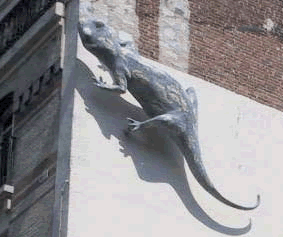Godzilla in Paris

- SUBSCRIBE
- ALREADY SUBSCRIBED?
BECOME A BONJOUR PARIS MEMBER
Gain full access to our collection of over 5,000 articles and bring the City of Light into your life. Just 60 USD per year.
Find out why you should become a member here.
Sign in
Fill in your credentials below.

Hardly. But a bigger-than-life, building-hugging salamander—one whose very presence is shrouded in mystery—oh yes. The 10-foot-long beast, sculpted in bronze and now fittingly blackened by the elements, is mounted astride an old masonry apartment building in the 20th arrondissement at the corner of Rue Vitruve and Rue Albert Marquet. Beside a trail of the creature’s footprints on the lower half of the wall is inscribed (in French) a disconcertingly brief reason for the salamander’s being there: “It has stopped to rest.” Rest from what? Coming from where? Headed where? Stuck, for what earthly reason, on a wall in a working class district of Paris? Some letters in the sculptor’s signature have been chipped away, an obvious act of vandalism, leaving clear only the year of the salamander’s arrival: 1991.
Because this four-legged amphibian is somewhat of a neighborhood newcomer, one might assume residents can explain its presence. Not so. Adults you meet on Rue Vitruve, a bustling artery of 20eme, say they have no idea why the salamander’s feet are planted in a nearby building wall; Nor do they seem to care. One elderly man grumbled, “I never even look up at it.” Neighborhood children do, however. As they approach the wall, the younger ones appear intimidated, as if they fear the creature will dislodge itself and chase them down the street. The older kids are amused. Three 12-year-old boys, winded from kicking a soccer ball around in the narrow, block-long Rue Albert Marquet, easily agreed (in one word and in English yet!) on how they regard the salamander: “Cool.” Echoing this opinion are Flaneurs (aimless strollers) who’ve stumbled upon the unlikely spectacle.
The best way to check it out is to take Metro Line 9 to the Maraichers station, walk four blocks north on Rue des Pyrenees to Rue Vitruve, and proceed right on Vitruve for one block. Another option is to board Bus 26 headed for Cours de Vincennes, get off at the Orteaux stop, walk east on Rue des Orteaux for one block, and then turn left into the little Rue Albert Marquet. But let’s face it – even the most purposeful sightseer would hesitate to go to an outlying district without greater enticement. In this case, the carrot may be Les Allobroges. Located a block and a half south of the Maraichers Metro station, this little neighborhood restaurant is known for its contemporary cuisine and has been recognized by the prestigious Michelin Guide. Dishes featuring fresh vegetables and herbs are prepared here by long-time chef Olivier Pateyron, and attract discriminating diners from all over the city.
Salamander footnote: Be advised that, unlike the bronze sculpture, a living European salamander measures no more than eight inches long, has a fat little head, is poisonous, sluggish and shy, and hibernates underground. Moreover, an actual salamander is not flamboyant like its legendary counterpart and cannot possibly live through fire—even though that’s what King Francois I’s coat of arms suggests, with its emblematic, undaunted salamander engulfed in flames. In other folklore, the salamander’s skin was said to be so incombustible that a fireproof cloth (asbestos) could be made from it. Cool, non?


